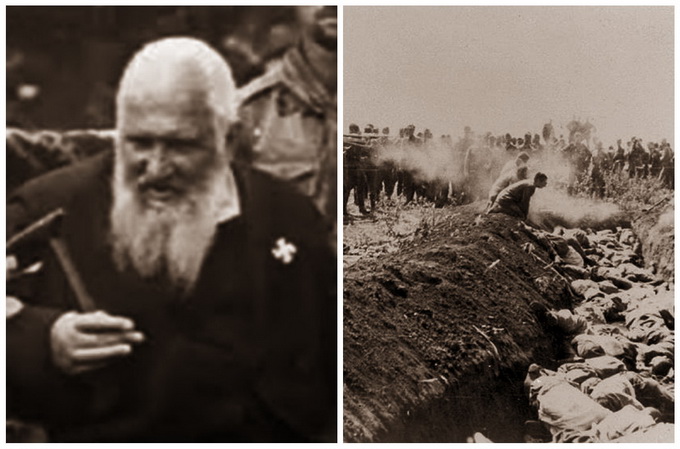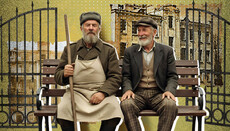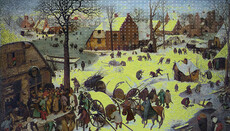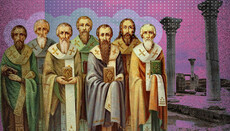From Sheptitsky to Babi Yar

The visit of the head of the State of Israel Reuven Rivlin and his speech at the Verkhovna Rada parliamentary hearings "75th anniversary of the Babi Yar tragedy: the lessons of history and the present" caused a great public resonance and indignation of some Ukrainian politicians. In his address to the people's deputies, President Rivlin said: "About 1.5 million Jews were murdered in the territory of modern Ukraine during World War II, at Babi Yar and in many other places. They were shot in the forest near ravines and pushed into mass graves. Many Ukrainians were accomplices of the crimes. OUN fighters especially stand out among those, who assaulted and mocked the Jews, murdered them, and in many cases, gave them away to the Nazis."
The OUN involvement in the crimes committed by the Nazi invaders in September 1941 in Kiev is still a controversial issue for heated public and scientific debates.
All the dialectic of modern apologists, who are strongly determined to "cover" for Ukrainian collaborators, comes down to several points, namely:
– not all members of the OUN armed formations fought on the side of the occupants;
– having agreed to collaborate with the occupation authorities, they did not necessarily participate in the executions and atrocities committed against the peaceful Ukrainian population.
Not long ago, director of the Ukrainian Center for Holocaust Studies Anatoly Podolsky said: "Today the Ukrainian historians of about 30 or a little more are engaged in research of collaboration. They are not afraid to write about it – not only about those who saved, but also about those who did not save. They say: "It is our past", not extrapolating the blame to the people living today in the country. We must take responsibility for the memory of the past and, more importantly, do not let the politicians instrumentalize the past history, taking it out of context."
So, one of those who "did not save" was Andrei Afanasievich Melnik. The history of his "heroic deeds" dates back to as far as World War I, when he, being a lieutenant of a hundred of Ukrainian Sich riflemen, participated in the Battle on Mount Lysonya (September 1916) as part of the Austro-Hungarian coalition forces against the Russian army.
For over 20 years, he was actively involved in civic and political activities, including one of the organizers of the semi-legal military revolutionary political formation known as the "Ukrainian Military Organization" (August 1920). The head of the UMO was Eugene Konovalets.
Somewhat later, in 1929, the Organization of Ukrainian Nationalists (OUN) was created in Vienna. The OUN emerged as a union between the Ukrainian Military Organization, smaller radical right-wing groups, and right-wing Ukrainian nationalists and intellectuals. It is easy to guess who became its "chief" – all the same Eugene M. Konovalets. The new organization based on the idea of the Natiocracy (the main motto was "State above all!") gradually got closer to the Social Democrats, who came to power in Germany. The OUN began to actively collaborate with the German secret services. In Berlin and Danzig (today Gdansk, Poland), telegraphist and military trainer courses were opened.
Konovalets wrote to his confessor Metropolitan Andrei Sheptitsky: "Everything is going well. A happy beginning of 1933 set the conditions under which our liberation campaign is gaining tremendous momentum and power. Time tested our friendship and collaboration with the Germans, and having tested, showed that, despite repeated temptations to come to terms with the Poles, we have chosen the only correct orientation. We owe this solely to Your Excellency."
Military training of OUN members engaged professionals from Division II of the Nazi Germany military intelligence (Abteilung Abwehr II Sonderdienst), specializing in terrorist attacks, sabotage and performing specific tasks.
So, Ukrainian nationalists were trained on a regular basis for combat operations in the territory of a future enemy, i.e. Poland; they were responsible for staging uprisings, exacerbating social tensions and instability and destruction of important objects.
After the assassination of the head of the OUN E.M. Konovalets, in September 1938 his deputy Andrei Melnik arrived in Danzig (Gdansk, Poland). Konovalets and Melnik had not only business ties. They had known each other since the days of their captivity in 1916. Andrei Melnik owed the killed man a lot. In the late 20s he was imprisoned for terrorist activities by the Polish government. After serving the prison sentence, Melnik worked as the managing director of forests on the huge estates of the Metropolitan of the Ukrainian Greek Catholic Church, Andrei Sheptitsky. He owed his appointment to the Metropolitan’s personal advisor and banker Stepan Fedak (senior), whose daughter, Olga, was married to Konovalets. By the way, over time, Melnik married her sister Sophia, and also became Fedak’s son-in-law.
Let us return to the events of autumn 1938. On September 11 the meeting of the "narrow OUN leadership circle" took place, in which A. Miller took over the Ukrainian nationalist movement and organizations of the OUN-UMO. Also he was to chair II Congress of Ukrainian Nationalists planned earlier by E. Konovalets.
Staying in Poland was unsafe. So for security reasons Melnik went to Berlin, and further to Rome, where II Congress of Ukrainian Nationalists was held on August 27, 1939. A. Melnik was chosen the head of the organization. He was granted the title of a "leader", declaring being accountable only "before God, the nation and his own conscience".
The election of Melnik was fully supported and approved by Metropolitan Andrei Sheptitsky, who was actively involved in the internal affairs of the OUN. Ideological positions of Sheptitsky and the nationalists coincided on some issues. They both were opposed to materialism and communism, advocated an independent Ukrainian state and hoped to unite the Orthodox and the Greek Catholics in a single Ukrainian church.
UGCC Archbishop John Buchko (former assistant of Metropolitan Andrei Sheptitsky since 1929) wrote the following about Andrei Melnik: "Colonel Melnik is the best person the Ukrainians could have ever had as a leader. Hard-working, pious and respected by all – he is a man of deeds not words ... He never break trust ... Andrei Melnik enjoys trust among the people and the nation is proud of him."
In autumn 1939, Western Ukraine became part of the Ukrainian Soviet Socialist Republic. OUN members reacted differently to this event. The younger and more zealously took the side of Stepan Bandera, who offered to work in small subversive groups in Galicia, then occupied by the Bolsheviks. The second group, headed by A. Melnik, took a more "moderate" view of the problem and believed that they should continue to adhere to the German policy, generating forces in exile for decisive action in the future.
In the ranks of the Ukrainian nationalists there was a "division", which led to the final break at the Krakow OUN Congress in February 1940. The OUN was divided into two factions: the OUN (b) named after Stepan Bandera, in contrast to the OUN (m) headed by A. Melnik. The two rival organizations became known as Melnikites and Banderites. The division among "fighters for independence of Ukraine" was deeply felt by Metropolitan Andrei Sheptitsky of the UGCC, but we assume that eventually he took the side of Melnik’s faction.
So, from the beginning of the 40's Melnik lived in Berlin, where he supervised underground work in the territory of the USSR. In August 1939, Franz Wilhelm Canaris, the head of the intelligence service of the Third Reich, promised Melnik that after the territory of Western Ukraine was taken by German troops, the latter will be appointed the leader of the Ukrainian people. Former ideologist of the OUN N.Stsiborsky (the author of "Natiocracy" idea) even made a draft constitution, according to which Ukraine was supposed to form a "totalitarian, authoritarian, corporate state" headed by Melnik.
In July 1941, Andrei Melnik, after the German invasion of the Soviet Union, sent a letter to Adolf Hitler, which states: "The Ukrainian people like no other, struggling for their freedom, soul imbued with the ideals of the new Europe. The desire of the Ukrainian people is to take part in the implementation of these ideals. We, the old freedom fighters of 1918-1921, ask you for the honor to us and our Ukrainian youth to participate in a crusade against Bolshevik barbarism. Along with the Legions of Europe, we also ask you to give us the opportunity to march shoulder to shoulder with our liberators – the German Wehrmacht and create for this purpose the Ukrainian fighting force."
On 2-3 August 1941, "the Bukovina kuren", a paramilitary unit, which consisted of soldiers from marching groups of the OUN (Melnikites), was formed. The founder of the "hut" and its first head was Petro Voynovsky. This unit was created by agreement of Melnik and Canaris, thus it was fully funded by the German intelligence service. It was sent with the permission of the German command to the occupied Ukrainian territories to form the collaborationist administration and police.
By the way, the kuren was accompanied by the above-mentioned N. Stsiborsky, who was assassinated in August 30, 1941, in Zhitomir, and therefore could not come to Kiev, which OUN fighters so frantically sought.
Kiev fell on 19 September 1941 ... On September 23, Metropolitan Sheptitsky sent a congratulatory letter to Hitler on this occasion, in which he wrote: "Your Excellence! As head of the Ukrainian Greek Catholic Church, I give Your Excellence my heartfelt congratulations on taking the capital of Ukraine, the golden-domed city on the Dnieper – Kiev! .. We see in you the undefeated commander of the unrivalled and glorious German Army! The destruction and eradication of Bolshevism, which you as the Fuehrer of the Great German Reich are aimed at in this campaign, is highly appreciated by the whole of Christendom. The Ukrainian Greek Catholic Church knows the true meaning of a mighty movement of the German people under your leadership ... I will pray to God for the blessing of victory that would guarantee lasting peace for your Excellence, the German Army and the German people. "
Together with advanced units of the Wehrmacht, the city was entered by the fighters of "Bukovina’s kuren". Mr. Melnik himself also arrived in Kiev on September 21, 1941. At that time another unit – "the Kiev kuren" – was formed under the OUN (m) in September 41.
Both of these units were actively involved in massacres at Babi Yar, arrests and executions of Kievites. "Melnikites" preached a total anti-Semitism. In one of the leaflets, which was addressed to the young Ukrainians, he said: "The OUN is bringing You, the Ukrainian youth, liberation, freedom and a bright national natural life on your land, where there will be neither Katsap(Russian), nor Hebe (Jew), nor Lyakh(Pole)". The leaflet of July 5, 1941 signed by Andrei Melnik said: "Death to Judaic henchmen – Communobolsheviks ".
In October-November 1941, Bukovina and Kiev kurens were disbanded, and on their basis the Kiev Auxiliary Police under the command of Petro Zakhvalynsky, as well as the 115th and the 118th schutzmannschaft battalions, were established.
Former head of the "Bukovina kuren" P.A. Voynovsky after the dissolution of the divisions was appointed the commander of the punitive battalion as SS Sturmbannführer.
P. Zakhvalynsky held the position of the Kiev Police Commander in Chief till the beginning of 1942. In late 1942 he took up the post of centurion of 2nd hundred of 115th Schutzmannschaft Squadron, which carried out the punitive operations against the guerrillas first in Ukraine, then in Belarus. On March 22, 1943, the squadron, together with soldiers of the SS-Sturmbrigade Dirlewanger took part in the total burning of the inhabitants of the Belarusian village of Khatyn ...
Today one may read that Mr. Melnik steadily advocated the idea of creating an independent Ukrainian state, for which he was arrested by the Gestapo and from February 1944 stayed at the Sachsenhausen concentration camp.
After the war he lived in Germany and Luxembourg, where he was actively engaged in the consolidation of Ukrainian emigration forces. In contrast to the murdered women, children and old people in Babi Yar, fate was more favorable to Andrei Afanasievich.
0
0
If you notice an error, select the required text and press Ctrl+Enter or Submit an error to report it to the editors.
Read also

When the ice breaks: Why winter cannot outlast spring
20 December 10:00

How Uncle Kolya the janitor believed in God
16 December 18:10

God in the queue: Why Bruegel’s painting shows no Christmas glory
15 December 18:22

Not magic, but faith: Christian code of The Lord of the Rings
13 December 13:44







